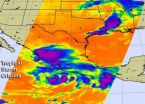(Press-News.org) Newly published research co-authored by scientists at Simon Fraser University and the Raincoast Conservation Foundation shows juvenile coho salmon benefit from dining on the distant remains of their spawning pink and chum cousins.
While juvenile coho salmon feed directly on spawning pink and chum salmon carcasses and eggs, even coho with no direct contact with spawning pink and chum benefit from their nutrient contributions to stream ecosystems.
The new research shows that juvenile coho abundance is up to three times higher in streams with abundant pink and chum compared to streams with none.
John Reynolds, an SFU biologist, and Michelle Nelson, one of his doctoral students, have just had their paper Time-delayed subsidies: Interspecies population effects in salmon published in PLOS ONE, an international peer-reviewed journal.
The authors say their discovery underscores the importance of understanding how a fish's nutrient legacy in streams and forest ecosystems affects species close and distant to them.
The paper's lead author Nelson says: ""We found an indirect link between spawning pink and chum salmon, and juveniles of another species, coho." The paper is one chapter of her thesis.
The carcasses of dead pink and chum salmon that have spawned in freshwater fertilize stream and forest ecosystems. The food web pathway may go from carcasses to algae to stream-insects and then to coho. Even more fascinating is a pathway that may go from carcasses to forest flies to coho.
"We know this isn't just because all three species benefit from being in nutrient-rich streams," says Reynolds, SFU's Tom Buell BC Leadership Chair in Salmon Conservation. "The habitat needs of pink, chum and coho are slightly different, and even taking habitats into account, the effects of coho dining on nutrients enriched by pink and chum remains are very clear."
"I hope this will highlight to fisheries decision-makers the ecological benefits of robust populations of spawning salmon," says Nelson. "Pink and chum salmon have less commercial and recreational value than coho. But their crucial contribution to stream ecosystems may benefit the health of coho populations."
Reynolds adds: "These findings are relevant to many people, considering the strong interest and connection many have with salmon. It also speaks directly to the federal Department of Fisheries and Oceans' commitment to incorporate a better understanding of salmon-ecosystem interactions into fisheries management to conserve and restore salmon abundance in our region."
INFORMATION:
The research was conducted in collaboration with the Raincoast Conservation Foundation and the local Heiltsuk First Nation.
Backgrounder:
Michelle Nelson spent five field seasons in the Great Bear Rainforest visiting more than 25 streams to conduct her research. Dogged by constant rain, Nelson could only access the streams, which were in almost pristine wilderness, by boat. Wolves, black bears and bald eagles were her constant companions.
She captured and measured juvenile coho salmon, and matched them to data from a long-term study by Reynolds and his students studying chum and pink salmon, including about 50 variables representing habitat characteristics.
Nelson expects to finish her doctorate in conservation biology studying salmon-ecosystem interactions under Reynolds' supervision in July.
Nelson regularly writes magazine and newspaper articles about food, travel and urban life in the context of conservation. Douglas and McIntyre will publish her first book, on urban homesteading and conservation, next spring.
She was formerly involved in sea lice/salmon research with Alexandra Morton, an independent biologist and SFU honorary degree recipient, and she teaches undergraduate field courses in ecology.
John Reynolds heads up a large team studying aquatic conservation and ecology, focusing on issues related to salmon conservation.
Contact:
John Reynolds, 778.782.5610, 604.786.0790 (cell), Reynolds@sfu.ca, Twitter: @JohnReynoldsSFU
Michelle Nelson (Bowen Island resident), 604.220.0214, mcnelson@sfu.ca
Carol Thorbes, PAMR, 778.782.3035, cthorbes@sfu.ca
Photos: http://at.sfu.ca/QjLRJi
The Tom Buell Foundation, the B.C. Leading Endowment Fund and the Pacific Salmon Foundation support Reynolds' research chair.
He has held a variety of scientific advisory positions, including with the B.C. Pacific Salmon Forum and the Cohen Commission. He has examined issues ranging from the negative impacts of salmon farming on wild fish to declines in Fraser sockeye salmon.
Simon Fraser University is consistently ranked among Canada's top comprehensive universities and is one of the top 50 universities in the world under 50 years old. With campuses in Vancouver, Burnaby and Surrey, B.C., SFU engages actively with the community in its research and teaching, delivers almost 150 programs to more than 30,000 students, and has more than 125,000 alumni in 130 countries.
Simon Fraser University: Engaging Students. Engaging Research. Engaging Communities
Coho salmon: Pinks' and chums' eating cousin
2014-06-10
ELSE PRESS RELEASES FROM THIS DATE:
Genetics reveal that reef corals and their algae live together but evolve independently
2014-06-10
New research reveals that Caribbean corals and the algae that inhabit them form a remarkably stable relationship -- new knowledge that can serve as an important tool in preserving and restoring vital reef-building corals. A scientific paper describing these new findings by a team of marine biologists at Penn State University will be published as a cover article in Molecular Ecology on 10 June 2014.
Coral reefs are important for protecting shorelines, providing seafood, and generating millions of dollars in recreation revenue each year, but rising water temperatures due ...
Miriam Hospital study shows how to make statewide health campaigns more effective
2014-06-10
PROVIDENCE, R.I. - Researchers from The Miriam Hospital have found that adding evidence-based weight loss strategies to a statewide wellness campaign improves weight loss outcomes among participants. The study and its findings are published online in advance of print in the American Journal of Public Health.
Lead researcher Tricia Leahey, Ph.D., and her colleagues chose to conduct a study among participants in Rhode Island's annual, three-month statewide health campaign. Called Shape Up Rhode Island (SURI), the campaign was founded in 2005 and takes a grass roots approach ...
NASA sees Tropical Storm Christina's birth and severe weather in US South
2014-06-10
NASA's Aqua satellite captured a picture of newborn Tropical Storm Cristina on June 10, marking the birth date of the Eastern Pacific Ocean's third tropical storm of the season. The same image showed the severe weather affecting the south central U.S.
Although not at the coastline, the National Hurricane Center said that Cristina is near enough to cause dangerous surf conditions.
According to the National Hurricane Center (NHC), swells generated by Cristina are affecting portions of the south-central coast of western Mexico. These swells will likely continue through ...
NASA-NOAA's Suomi NPP satellite spots Arabian Sea tropical cyclone
2014-06-10
Tropical Cyclone 02A formed in the Arabian Sea as NASA-NOAA's Suomi NPP satellite passed overhead and captured a visible photo of the storm, spotting strongest storms south of its center.
On June 10 at 08:21 UTC (4:21 a.m. EDT), when Suomi NPP passed over 02A, the Visible Infrared Imaging Radiometer Suite (VIIRS) instrument aboard captured a visible image of the storm. VIIRS collects visible and infrared imagery and global observations of land, atmosphere, cryosphere and oceans.
In the image, Tropical Storm 02A appeared slightly elongated but satellite data shows that ...
NASA's SDO sees a summer solar flare
2014-06-10
The sun emitted a significant solar flare, peaking at 7:42 a.m. EDT on June 10, 2014. NASA's Solar Dynamics Observatory – which typically observes the entire sun 24 hours a day -- captured images of the flare.
Solar flares are powerful bursts of radiation. Harmful radiation from a flare cannot pass through Earth's atmosphere to physically affect humans on the ground. However, when intense enough, they can disturb the atmosphere in the layer where GPS and communications signals travel.
To see how this event may affect Earth, please visit NOAA's Space Weather Prediction ...
Inside the adult ADHD brain
2014-06-10
CAMBRIDGE, MA -- About 11 percent of school-age children in the United States have been diagnosed with attention deficit hyperactivity disorder (ADHD). While many of these children eventually "outgrow" the disorder, some carry their difficulties into adulthood: About 10 million American adults are currently diagnosed with ADHD.
In the first study to compare patterns of brain activity in adults who recovered from childhood ADHD and those who did not, MIT neuroscientists have discovered key differences in a brain communication network that is active when the brain is at ...
Mammography has led to fewer late-stage breast cancers, U-M study finds
2014-06-10
ANN ARBOR, Mich. — In the last 30 years, since mammography was introduced, late-stage breast cancer incidence has decreased by 37 percent, a new study from the University of Michigan Comprehensive Cancer Center finds.
The analysis takes into account an observed underlying trend of increased breast cancer incidence present since the 1940s, a sort of inflation rate for breast cancer.
Researchers looked at early-stage and late-stage breast cancer diagnoses between 1977-1979, before mammography became popular, and compared it to diagnoses between 2007-2009. Based on trends ...
A plan to share the carbon budget burden
2014-06-10
PROVIDENCE, R.I. [Brown University] — Climate change is an issue of urgent international importance, but for 20 years, the international community has been unable to agree on a coordinated way to reduce greenhouse gas emissions. In a "Perspective" piece published in the June issue of Nature Climate Change, J. Timmons Roberts, the Ittleson Professor of Environmental Studies and Sociology, proposes a four-step compromise toward emissions reduction that offers "effectiveness, feasibility, and fairness."
Their proposal comes as another major United Nations meeting on climage ...
Soldiers who kill in combat less likely to abuse alcohol
2014-06-10
WASHINGTON, D.C. (June 10, 2014)—It's no secret that combat experiences are highly stressful and can contribute to instances of post-traumatic stress disorder and depression among soldiers post-deployment. It also comes as no surprise that many soldiers afflicted with these conditions abuse alcohol in an attempt to self-medicate.
But new research coauthored by Cristel Russell, an associate professor of marketing with American University's Kogod School of Business, and researchers with the Walter Reed Army Institute of Research finds that the most traumatic of all combat ...
New biometric watches use light to non-invasively monitor glucose, dehydration, pulse
2014-06-10
WASHINGTON, June 9—Monitoring a patient's vital signs and other physiological parameters is a standard part of medical care, but, increasingly, health and fitness-minded individuals are looking for ways to easily keep their own tabs on these measurements. Enter the biometric watch.
In a pair of papers published in The Optical Society's (OSA) open-access journal Biomedical Optics Express, groups of researchers from the Netherlands and Israel describe two new wearable devices that use changing patterns of scattered light to monitor biometrics: one tracks glucose concentration ...







